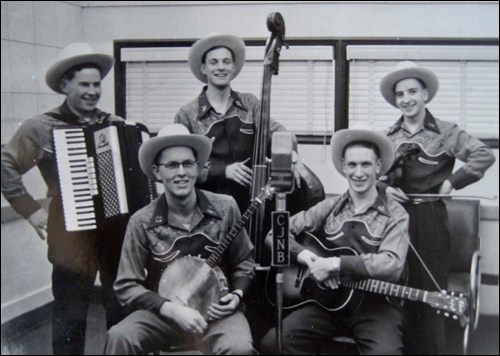After the Oddfellows departed in 1950, their former facility was converted into a fine community dance hall and renamed the Co-op Hall. The Co-op store was located below on the main floor.
The hall, which was accessed by a door located at sidewalk level on the east side of the building and stairs to the second level, boasted a hardwood floor and a capacity of close to 200. So, it was not surprising the hall was solidly booked for dances, parties and community functions after the Oddfellows had vacated the premises.
It was interesting to note a dance hall and banquet facility known as Truckadero operated directly across the street where the H&R Block, Cheques Cashed and Klassy Kutts are now located, although not in the original building. Joyce George remembers her wedding reception and dance at the Truckadero in 1950, and also dancing the night away at the Co-op Hall in the early 1950s.
Jack Bouma, a guitar player with the popular Melody Ranch Boys, recalled playing for some great dances at the Co-op Hall in the early 1950s. Wages were not high - $5 to $10 per band member depending on the type of gig, although they didn't call them gigs in those days. Jack described the hall as excellent and the dance crowds as energetic and up for a party.
One minor drawback, however, was that the washrooms were located a considerable distance from the dance floor. Jack related that on one occasion a reveller, in desperate straits, hurried through the fire escape door on the northeast corner, and made a nature call over the railing. Unfortunately, a few men had gathered below in the dark for whiskey shots. Jack recalled they did not have much of a sense of humour because there was enthusiastic swearing.
Long-time resident, Jack Abbott, remembered the Co-op Hall as a fine place for get-togethers and parties. Mr. Abbott remembered a particular Christmas party at which his young son Dave, who grew up to become a highly accomplished and versatile musician, sang Little Arrows accompanied by Wanda Whitwell, also a fine musician. Little Dave was a big hit.
Joanna Morrow, a former resident who grew up in the city, related that from 1950 to '54, a teen social club was located in the Co-op Hall and open in the evenings. The club was operated by Don Mullen, a DJ whose parents owned a meat cutting/retail business on Main Street (100th Street). Vinyl records, energetic dances, especially the jive, and soda refreshments were the order of the day at this popular teen gathering place on 11th Avenue.
More Businesses and Agencies
John Fisher related that the North Battleford Board of Trade, which later became the Battlefords Chamber of Commerce, held its regular meetings in the late 1950s and '60s in this building, in the bus depot cafe. In addition to John Fisher, prominent chamber names included James Maher, Irwin C. McIntosh and Bill Wheeldon.
McKay's Barbershop also served the public from this building for many years during the 1960s, '70s and '80s. The barbershop was located at the front of the building on the west side. The distinctive red and white barber pole is still there.
Restaurants and cafe's which operated from the building over the decades included the South Vietnamese Restaurant, Delbello's Family Restaurant, Peter's Cafe, Town and Country Restaurant, Bus Depot Restaurant, B & L Restaurant, and Pathway Restaurants Ltd.
In addition to those businesses and agencies already mentioned, the Bentax Discount Centre, H & R Block, government leased office space - Department of Agriculture, Department of Labour, Municipal Affairs District Office, and Farm Credit - located on the second floor of the old bus depot building during the 1960s to the '80s.
Gradually, businesses and agencies relocated elsewhere in the city. The last tenant to vacate the building was the South Vietnamese Restaurant in 2002. Its business signs are still intact on the front and east sides of the building. Over the years, the co-op dance hall on the second floor fell into disuse and the building into disrepair.
Like the Sallows & Boyd, this historic building has sat empty and deteriorating for many years. Even so, its exterior walls appear to be sound. Despite that the owner wishes to preserve the old bus depot, there has been talk of razing the building along with the Sallows & Boyd. But demolition of a century-old historic building in the city centre, which has already lost so much of its architectural heritage, is not realistic - not if we wish to restore North Battleford's historic quarter and rebuild and revitalize the downtown core.
Researching material for an article on one of our city's historic buildings is always a challenge. Gathering data on the STC bus enterprise at the old bus depot was more daunting than most assignments. I found some information in old newspapers. The city's building department provided some important facts concerning the building's tenants for which I am very appreciative, but there was surprisingly little print or digital data anywhere else. Even the provincial government STC archives yielded little.
So, I had to rely on the personal accounts of some of our older citizens, and former citizens, whose names are mentioned in the article. They told me what they remembered. To them I am indebted, and I owe them a large thank you.




